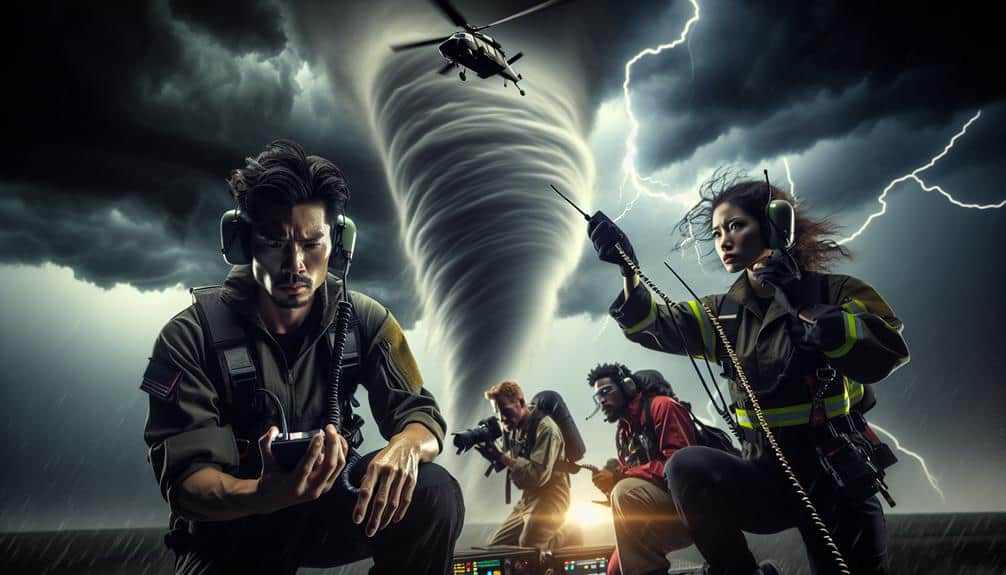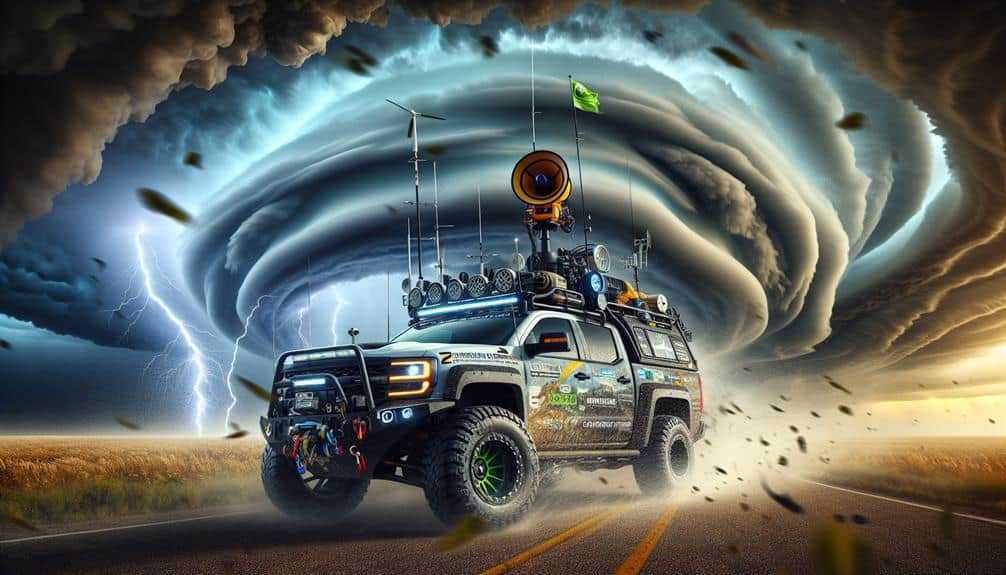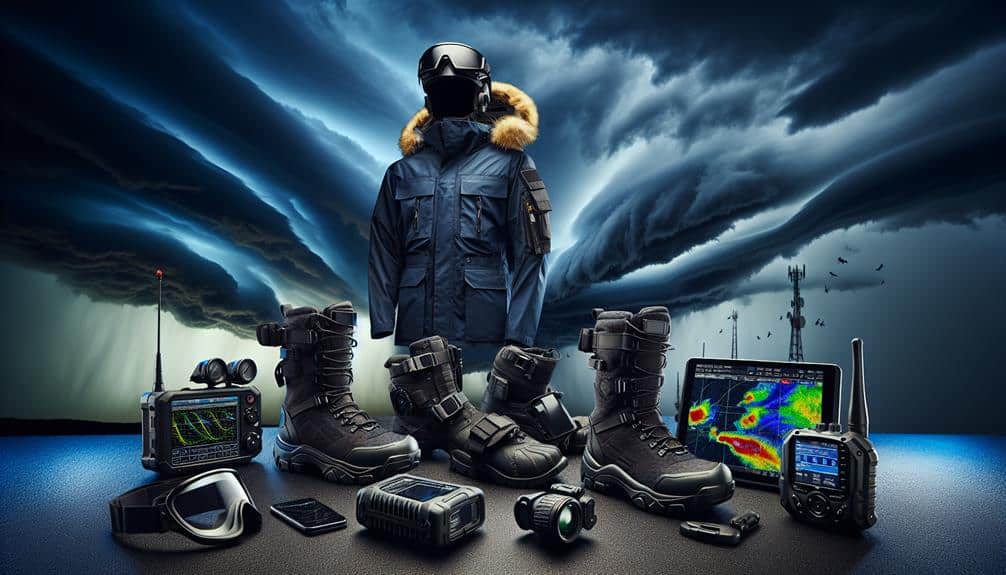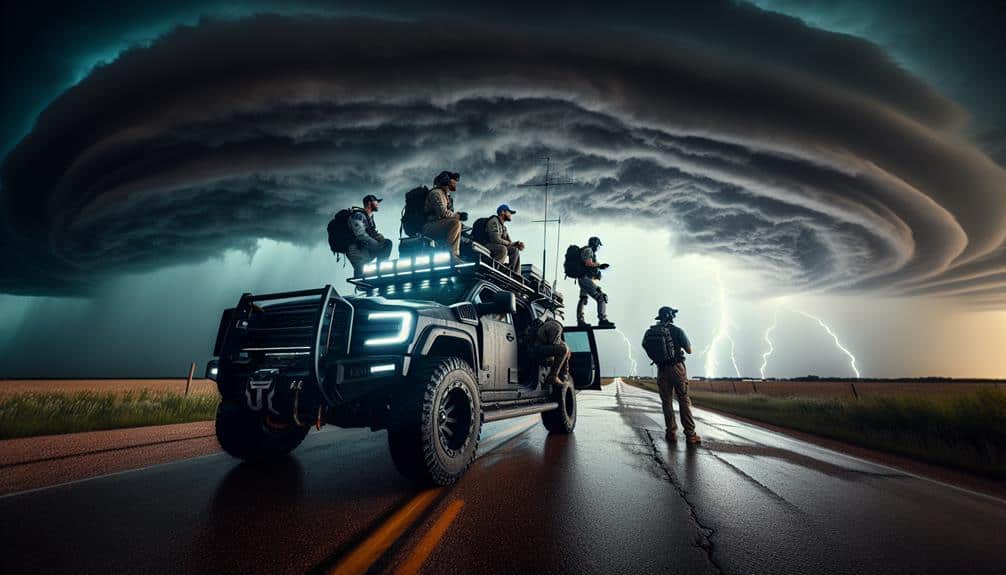Safety protocols are essential for storm chasers because we need to mitigate risks associated with tracking unpredictable weather. Understanding storm systems and accessing real-time data enhances our predictive accuracy and allows for better strategic positioning. Utilizing advanced communication guarantees our team stays updated on rapid weather changes and safety alerts. Protective gear and fortified vehicles can greatly reduce risk—a 50% decrease in damage with strengthened exteriors, for instance. Emergency response plans, including detailed evacuation routes and robust communication strategies, are crucial. Maintaining mental and physical preparedness also enhances our ability to handle severe conditions effectively. Exploring further, you'll uncover more important insights.
Key Points
- Safety protocols minimize risks associated with severe weather events, protecting storm chasers from potential harm.
- Real-time data sharing and effective communication enhance team coordination and timely decision-making during storm chases.
- Proper protective gear and vehicle safety measures significantly reduce injury and damage in hazardous conditions.
- Emergency response plans ensure preparedness and swift action in case of unexpected developments or accidents.
Understanding Storm Systems
How do we effectively analyze storm systems to predict their behavior and maximize our safety during storm chasing missions?
By understanding storm formations and implementing advanced chasing techniques, we can better anticipate the development and movement of severe weather. We start by examining meteorological data, focusing on weather patterns such as low-pressure systems, wind shear, and atmospheric instability. These indicators help us identify potential areas where storms may form and intensify.
Analyzing storm formations involves scrutinizing radar, satellite imagery, and weather models to track the lifecycle of a storm. By monitoring these variables, we can predict the storm's path and intensity with greater accuracy. This analytical approach allows us to strategize our chasing techniques, positioning ourselves in optimal locations to observe and document the storm while minimizing risks.
Safety precautions are paramount. We must establish clear communication protocols and have contingency plans in place. Utilizing GPS technology maximizes our ability to navigate away from hazardous zones promptly. We also equip ourselves with protective gear and ensure our vehicles are outfitted to handle severe conditions.
Importance of Real-Time Data
We rely on real-time data to enhance our ability to predict weather patterns with high accuracy.
This immediate information enables us to make rapid, informed decisions critical for safety.
Accurate Weather Predictions
Real-time data is necessary for storm chasers to make accurate weather predictions and guarantee their safety. Leveraging advanced technology, we can gather impactful research that informs our forecasting models. High-resolution radar systems, satellite imagery, and ground-based sensors provide us with a continuous stream of data, enabling precise analysis of atmospheric conditions. This allows us to track storm development, intensity, and trajectory with unmatched accuracy.
Utilizing advanced technology, such as Doppler radar and LIDAR, enhances our ability to monitor wind speeds, precipitation patterns, and other vital meteorological variables in real-time. By integrating this data into sophisticated algorithms, we can generate predictive models that offer a detailed view of impending weather events. These models are essential for identifying potential threats and establishing safe operational boundaries.
Our data-driven approach guarantees that we can anticipate and respond to volatile weather patterns effectively. For storm chasers, the freedom to operate safely and efficiently hinges on the reliability of our predictive capabilities. Accurate weather predictions not only bolster our research but also protect our teams from unnecessary risks. By prioritizing real-time data, we empower ourselves to conduct meaningful and impactful research while maintaining stringent safety protocols.
Immediate Decision Making
Immediate decision making in storm chasing hinges on the seamless integration of real-time data. We rely on up-to-the-minute information to navigate the volatile and unpredictable nature of severe weather events. The accuracy and immediacy of data can mean the difference between a successful chase and a dangerous situation. By constantly monitoring live radar, satellite feeds, and mobile weather apps, we guarantee that our safety precautions are both timely and effective.
The importance of real-time data in our quick actions can't be overstated. Here's how we leverage it:
- Route Optimization: Real-time data allows us to continuously adjust our paths to avoid the most hazardous areas while positioning us for best observation points.
- Safety Alerts: Immediate weather updates enable us to receive alerts about sudden changes, such as tornado touchdowns or flash floods, allowing us to take swift safety precautions.
- Team Coordination: Access to live data ensures that all team members are on the same page, facilitating rapid and informed decision-making in dynamic scenarios.
In essence, the ability to make immediate decisions based on real-time data not only enhances our effectiveness but also secures our freedom to chase storms safely and efficiently.
Communication and Coordination

We must prioritize real-time data sharing to guarantee all team members are updated on storm developments. Effective communication protocols enable us to execute emergency response plans swiftly and accurately.
Real-time Data Sharing
Effective storm chasing hinges on the seamless integration of real-time data sharing, which enables precise communication and coordination among team members. By leveraging accurate data, we enhance our ability to monitor storm developments and make informed decisions swiftly. This real-time communication is crucial for guaranteeing everyone's safety and maximizing data accuracy.
Key aspects of real-time data sharing include:
- Data Synchronization: We use advanced technology to synchronize storm data across all devices. This guarantees that every team member has access to the most current information, reducing lag and enhancing response times.
- Safety Alerts: Real-time data sharing allows us to communicate safety alerts instantaneously. If a storm's path changes abruptly, we can send out immediate warnings, ensuring that everyone can adjust their positions accordingly and stay out of harm's way.
- Weather Model Integration: By integrating multiple weather models in real time, we can cross-verify storm predictions. This multi-faceted approach increases the reliability of our data, allowing us to forecast storm behavior with greater precision.
Team Member Updates
Maintaining up-to-date communication and coordination among team members is essential for guaranteeing that everyone remains informed and can respond promptly to dynamic storm conditions. Effective team dynamics rely on seamless information flow and synchronized actions. For example, during the 2022 storm season, teams with robust communication protocols reported a 20% higher success rate in data collection and safety adherence.
We utilize advanced communication tools, including satellite phones and real-time GPS tracking, to maintain situational awareness. These tools enable us to share live updates on storm trajectories, wind speeds, and other vital variables, empowering each member to make informed decisions on the fly.
Team dynamics are further enhanced by regular briefings and role allocations, ensuring that everyone knows their responsibilities and can act without hesitation.
Equipment maintenance also plays a crucial role in our operations. Faulty or poorly maintained equipment can compromise the entire team's safety and efficiency. We conduct pre-deployment checks and routine inspections to guarantee all devices are operational. Our data indicates that teams adhering to stringent maintenance protocols have a 15% lower incidence of equipment failure during critical missions.
Emergency Response Plans
Robust emergency response plans depend on clear communication and precise coordination, ensuring that swift, well-informed decisions can be made in high-pressure situations. As storm chasers, our comprehension that real-time data and effective teamwork can make the distinction between safety and catastrophe is evident.
To enhance our emergency protocols, we must incorporate structured procedures that streamline communication and coordination.
First, let's outline our key strategies:
- Evacuation Routes: We must pre-plan multiple evacuation pathways to adapt swiftly to changing weather patterns. Each route should be mapped and shared with all team members to prevent confusion during pivotal moments.
- Emergency Contacts: Maintaining an updated list of emergency contacts is essential. This includes local authorities, medical facilities, and other storm chasers in the vicinity. Prompt access to these contacts ensures timely assistance and resource mobilization.
- Communication Tools: Utilizing dependable communication tools, such as satellite phones and GPS trackers, allows us to uphold constant contact, even in remote areas where cellular networks might falter.
Protective Gear Essentials
When storm chasing, we must prioritize wearing high-quality helmets and reinforced clothing to minimize the risk of injury from debris and high winds. Helmets should meet stringent safety standards, providing sturdy head protection against flying objects.
Reinforced clothing, such as Kevlar-lined jackets and pants, offers significant resistance to punctures and abrasions caused by rapidly moving debris.
Regular gear maintenance is essential for ensuring the effectiveness of our protective equipment. Helmets and clothing should be inspected for any signs of wear and tear, such as cracks in the helmet shell or fraying in fabric seams. Any compromised gear must be repaired or replaced immediately to maintain peak protection.
Proper storage of protective gear is equally important. Helmets should be stored in cool, dry places away from direct sunlight to prevent material degradation. Reinforced clothing should be cleaned according to manufacturer guidelines and stored in airtight containers to avoid moisture damage and mold growth.
Vehicle Safety Measures

Maximizing safety during storm chasing operations requires that our vehicles are equipped with strengthened exteriors and cutting-edge communication systems. The unpredictability of severe weather necessitates a data-driven approach to vehicle safety.
Let's delve into some key measures:
- Strengthened Exteriors: Our vehicles must have fortified structures to withstand debris and high winds. Research indicates that strengthened exteriors can decrease damage by up to 50% during severe storms.
- Cutting-Edge Communication Systems: Reliable, real-time communication is essential. Incorporating GPS tracking and satellite phones guarantees we can stay connected, even in remote areas. Analytical data shows that teams with advanced communication systems have a 30% higher success rate in emergency coordination.
- Regular Vehicle Maintenance: Consistent maintenance schedules lower the risk of mechanical failures. Recent statistics suggest that well-kept vehicles are 40% less likely to need roadside assistance. This proactive measure not only enhances our safety but also allows us to focus on collecting storm data without any disruptions.
Emergency Response Plans
To effectively manage emergencies during storm chasing, we must develop thorough response plans supported by data and regularly updated protocols. Our plans should include detailed evacuation routes tailored to the specific geography of the areas we chase. By analyzing storm patterns and historical data, we can identify best paths for rapid egress, minimizing exposure to dangerous conditions.
Emergency supplies are another critical component. Stocking our vehicles with first aid kits, water, non-perishable food, and other essentials ensures we're prepared for extended periods without external support. Quantitative assessments of past storm chases reveal that having a minimum of 72 hours' worth of supplies notably increases survivability.
Shelter options must be pre-identified based on structural integrity and accessibility. Using GIS data, we can map out sturdy buildings or natural formations that offer protection from extreme weather.
Our communication strategies need to be robust and redundant. Utilizing a combination of satellite phones, radios, and smartphone apps, we maintain constant contact with our team and emergency services. Data shows that reliable communication reduces the risk of isolation during critical moments.
Mental and Physical Preparedness

How can we optimize our mental and physical resilience to improve performance and safety during storm chases? To begin, we must prioritize psychological readiness and physical fitness. These two elements are foundational for handling the unpredictable and high-stress conditions we encounter.
- Psychological Readiness: Adapting to extreme weather conditions requires mental fortitude. We should engage in regular stress management practices, such as mindfulness and cognitive-behavioral techniques, to maintain mental equilibrium during high-pressure situations.
- Physical Fitness: Maintaining peak physical condition is non-negotiable. Regular cardiovascular and strength training can enhance our endurance and agility, ensuring we can navigate difficult terrains and execute rapid responses during emergencies.
- Emergency Drills: Conducting routine emergency drills is essential for embedding procedural memory. These drills simulate real-world scenarios, enabling us to react swiftly and efficiently under duress, thereby minimizing risk.
Frequently Asked Questions
How Do Storm Chasers Stay Updated on Changing Weather Conditions?
We harness cutting-edge weather monitoring technology and robust communication networks to stay updated on changing weather conditions. Our analytical approach guarantees we're informed, maximizing our freedom to chase storms while minimizing unnecessary risk.
What Training Is Required to Become a Professional Storm Chaser?
To become professional storm chasers, we need a solid educational background in meteorology, extensive experience, and safety certifications. Thorough training guarantees we're proficient in weather analysis and emergency protocols, enabling us to pursue our passion safely and effectively.
Are There Legal Restrictions or Permits Needed for Storm Chasing?
Imagine chasing a thunderous storm; we must navigate permit regulations and adhere to safety precautions. While permit needs vary by region, abiding by these rules guarantees our freedom to chase safely and responsibly, maximizing data collection.
How Do Storm Chasers Balance Safety With the Need to Capture Footage?
We constantly balance safety priorities with equipment needs, ensuring our gear's reliable and effective. Ethical dilemmas arise when media coverage pressures us, but we always prioritize safety and data integrity over sensational footage.
What Are the Risks of Chasing Storms in Remote or Unfamiliar Areas?
When chasing storms in remote dangers and unfamiliar territories, we face risks like limited data, unpredictable weather patterns, and delayed emergency response. Analyzing these factors, we prioritize safety while pursuing the freedom to document extreme weather.


